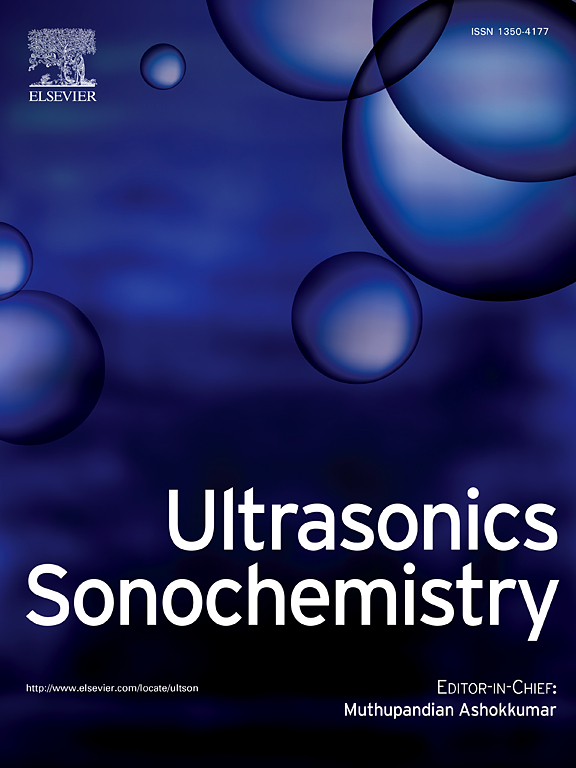Ultrasonic Activation of Persulfate for the Removal of BPA in 20, 28, and 300 kHz Systems
IF 8.7
1区 化学
Q1 ACOUSTICS
引用次数: 0
Abstract
The effect of ultrasound (US) on persulfate (PS) activation was investigated to determine whether acoustic cavitation can effectively induce PS activation for bisphenol A (BPA) degradation at 20, 28, and 300 kHz under various temperature conditions. The optimal liquid volume in the vessel was geometrically determined to be 400, 900, and 420 mL at 20, 28, and 300 kHz, respectively, using KI dosimetry and sonochemiluminescence image analysis. The pseudo-1st-order reaction kinetic constants in the only PS, only US, and US/PS processes at 20, 28, and 300 kHz were obtained under 5–10 ℃, 15–20 ℃, 25–30 ℃, 45–50 ℃, 55–60 ℃, and no temperature control conditions. No notable BPA degradation occurred at 5–10 ℃, 15–20 ℃, and 25–30 ℃ in the only PS processes for all frequencies. The highest sonochemical BPA degradation was obtained at 300 kHz, and much lower BPA degradation was observed at 45–50 ℃ and 55–60 ℃ for all frequencies in the only US processes. No notable enhancement of BPA degradation was observed at 5–10 ℃, 15–20 ℃, and 25–30 ℃ in the US/PS processes compared to the only US processes for all frequencies. At 20 kHz and temperatures between 55 and 60 ℃, the highest BPA degradation was obtained, with a synergistic effect of 171 %. However, the enhancement might be due to the instant or local temperature increase, and not due to acoustic cavitation. No notable PS activation by US irradiation was observed in the US/PS processes in this study. The profiles of the generated sulfate ion concentrations in the US/PS processes confirmed this. Some previous studies found high synergistic effects, whereas others have found low or no synergistic effects in US/PS processes.
超声波活化过硫酸盐去除20、28和300 kHz系统中的BPA
研究了超声(US)对过硫酸盐(PS)活化的影响,以确定在不同温度条件下,在20、28和300 kHz下,声空化是否能有效诱导PS活化以降解双酚A (BPA)。通过KI剂量学和声化学发光图像分析,几何确定了在20、28和300 kHz下容器内的最佳液体体积分别为400、900和420 mL。在5-10℃、15-20℃、25-30℃、45-50℃、55-60℃和无温度控制条件下,分别获得了20、28和300 kHz下纯PS、纯US和US/PS过程的拟一级反应动力学常数。在5 ~ 10℃、15 ~ 20℃和25 ~ 30℃条件下,双酚a降解均不显著。在300 kHz声化学双酚a降解最高,在45-50℃和55-60℃的所有频率下,只有US工艺的双酚a降解率要低得多。在5-10℃、15-20℃和25-30℃条件下,与单一的US工艺相比,US/PS工艺对BPA的降解没有显著的促进作用。在20 kHz和55 ~ 60℃的温度下,双酚a的降解率最高,协同效应为171%。然而,这种增强可能是由于瞬间或局部温度的升高,而不是由于声空化。本研究在US/PS过程中未观察到明显的PS激活。在US/PS过程中产生的硫酸盐离子浓度曲线证实了这一点。先前的一些研究发现了高度的协同效应,而另一些研究发现US/PS过程的协同效应很低或没有协同效应。
本文章由计算机程序翻译,如有差异,请以英文原文为准。
求助全文
约1分钟内获得全文
求助全文
来源期刊

Ultrasonics Sonochemistry
化学-化学综合
CiteScore
15.80
自引率
11.90%
发文量
361
审稿时长
59 days
期刊介绍:
Ultrasonics Sonochemistry stands as a premier international journal dedicated to the publication of high-quality research articles primarily focusing on chemical reactions and reactors induced by ultrasonic waves, known as sonochemistry. Beyond chemical reactions, the journal also welcomes contributions related to cavitation-induced events and processing, including sonoluminescence, and the transformation of materials on chemical, physical, and biological levels.
Since its inception in 1994, Ultrasonics Sonochemistry has consistently maintained a top ranking in the "Acoustics" category, reflecting its esteemed reputation in the field. The journal publishes exceptional papers covering various areas of ultrasonics and sonochemistry. Its contributions are highly regarded by both academia and industry stakeholders, demonstrating its relevance and impact in advancing research and innovation.
 求助内容:
求助内容: 应助结果提醒方式:
应助结果提醒方式:


